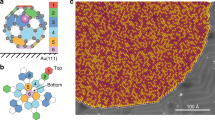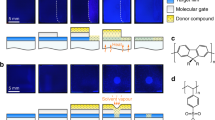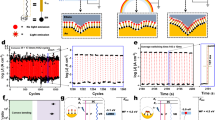Abstract
The ultimate miniaturization of future devices will require the use of functional molecules at the nanoscale and their integration into larger architectures1,2. Switches represent a prototype of such functional molecules because they exhibit characteristic states of different physical/chemical properties, which can be addressed reversibly3. Recently, various switching entities have been studied and switching of single molecules on surfaces has been demonstrated4,5,6,7,8,9,10,11,12,13. However, for functional molecules to be used in a future device, it will be necessary to selectively address individual molecules, preferentially in an ordered pattern. Here, we show that azobenzene derivatives in the trans form, adsorbed in a homogeneous two-dimensional layer, can be collectively switched with spatial selectivity, thus forming a periodic pattern of cis isomers. We find that the probability of a molecule switching is not equally distributed, but is strongly dependent on both the surrounding molecules and the supporting surface, which precisely determine the switching capability of each individual molecule. Consequently, exactly the same lattices of cis isomers are created in repeated erasing and re-switching cycles. Our results demonstrate a conceptually new approach to spatially addressing single functional molecules.
This is a preview of subscription content, access via your institution
Access options
Subscribe to this journal
Receive 12 print issues and online access
$259.00 per year
only $21.58 per issue
Buy this article
- Purchase on Springer Link
- Instant access to full article PDF
Prices may be subject to local taxes which are calculated during checkout




Similar content being viewed by others
References
Joachim, C., Gimzewski, J. K. & Aviram, A. Electronics using hybrid-molecular and mono-molecular devices. Nature 408, 541–548 (2000).
Heath, J. R. & Ratner, M. A. Molecular electronics. Physics Today 56, 43–49 (2003).
Feringa, B. L. Molecular Switches (Wiley-VCH, Weinheim, 2001).
Choi, B.-Y. et al. Conformational molecular switch of the azobenzene molecule: A scanning tunnelling microscopy study. Phys. Rev. Lett. 96, 156106 (2006).
Henzl, J., Mehlhorn, M., Gawronski, H., Rieder, K.-H. & Morgenstern, K. Reversible cis-trans isomerization of a single azobenzene molecule. Angew. Chem. Int. Ed. 45, 603–606 (2006).
Alemani, M. et al. Electric field-induced isomerization of azobenzene by STM. J. Am. Chem. Soc. 128, 14446–14447 (2006).
Hagen, S., Leyssner, F., Nandi, D., Wolf, M. & Tegeder, P. Reversible switching of tetra-tert-butyl-azobenzene on a Au(111) surface induced by light and thermal activation. Chem. Phys. Lett. 444, 85–90 (2007).
Comstock, M. J. et al. Reversible photomechanical switching of individual engineered molecules at a metallic surface. Phys. Rev. Lett. 99, 038301 (2007).
Pace, G. et al. Cooperative light-induced molecular movements of highly ordered azobenzene self-assembled monolayers. Proc. Natl Acad. Sci. 104, 9937–9942 (2007).
Tsai, C.-S., Wang, J.-K., Skodje, R. T. & Lin, J.-C. A single molecule view of bistilbene photoisomerization on a surface using scanning tunnelling microscopy. J. Am. Chem. Soc. 127, 10788–10789 (2005).
Katsonis, N. et al. Reversible conductance switching of single diarylethenes on a gold surface. Adv. Mater. 18, 1397–1400 (2006).
Liljeroth, P., Repp, J. & Meyer, G. Current-induced hydrogen tautomerization and conductance switching of naphthalocyanine molecules. Science 317, 1203–1206 (2007).
Alemani, M. et al. Adsorption and switching properties of azobenzene derivatives on different noble metal surfaces; Au(111), Cu(111) and Au(100). J. Phys. Chem. C 112, 10509–10514 (2008).
Hammett, L. P. The effect of structure upon the reactions of organic compounds. Benzene derivatives. J. Am. Chem. Soc. 59, 96–103 (1937).
Barth, J. V., Brune, H., Ertl, G. & Behm, R. J. Scanning tunnelling microscopy observations on the reconstructed Au(111) surface: Atomic structure, long-range superstructure, rotational domains and surface defects. Phys. Rev. B 42, 9307–9318 (1990).
Vladimirova, M. et al. Supramolecular self-assembly and selective step decoration on the Au(111) surface. Europhys. Lett. 56, 254–260 (2001).
Chen, W., Madhavan, V., Jamneala, T. & Crommie, M. F. Scanning tunnelling microscopy observation of an electronic superlattice at the surface of clean gold. Phys. Rev. Lett. 80, 1469–1472 (1998).
Madueno, R., Räisänen, M. T., Silien, C. & Buck, M. Functionalizing hydrogen-bonded surface networks with self-assembled monolayers. Nature 454, 618–621 (2008).
Meyer, G. A simple low-temperature ultrahigh-vacuum STM capable of atomic manipulation. Rev. Sci. Instrum. 67, 2960–2965 (1996).
Acknowledgements
The authors thank K.-H. Rieder, J.I. Pascual and M. Wolf for careful reading of the manuscript. Financial support was provided by the German Research Foundation (DFG) through the SFB 658 (projects A1 and B8) and through contract no. GR 2697/1-2. C.D. thanks the Fondazione CRTrieste for financial support. This research was funded by the Progetto D4 (European Social Fund, Regione Friuli Venezia Giulia and Italian Ministry of Welfare).
Author information
Authors and Affiliations
Contributions
S.H. and L.G. conceived the experiments. C.D. and L.G. performed the experiments and analysed the data. M.V.P., J.S. and S.H. synthesized the molecules. L.G. wrote the paper. C.D., S.H. and L.G. discussed the results and commented on the manuscript.
Corresponding authors
Supplementary information
Supplementary Information
Fig.1 to Fig.15 (PDF 8114 kb)
Rights and permissions
About this article
Cite this article
Dri, C., Peters, M., Schwarz, J. et al. Spatial periodicity in molecular switching. Nature Nanotech 3, 649–653 (2008). https://doi.org/10.1038/nnano.2008.269
Received:
Accepted:
Published:
Issue Date:
DOI: https://doi.org/10.1038/nnano.2008.269
This article is cited by
-
Reactions in single-molecule junctions
Nature Reviews Materials (2022)
-
Collective molecular switching in hybrid superlattices for light-modulated two-dimensional electronics
Nature Communications (2018)
-
Photo-regulated conductivity of polycaprolactone honeycomb-patterned porous films containing azobenzene-functionalized reduced graphene oxide
Macromolecular Research (2017)
-
Bias-induced conductance switching in single molecule junctions containing a redox-active transition metal complex
Monatshefte für Chemie - Chemical Monthly (2016)
-
Controlling intramolecular hydrogen transfer in a porphycene molecule with single atoms or molecules located nearby
Nature Chemistry (2014)



